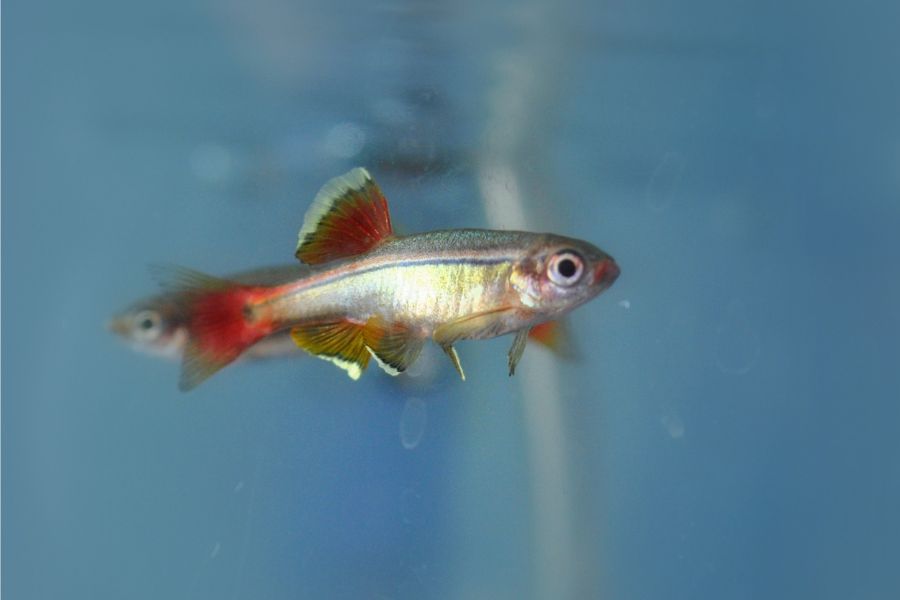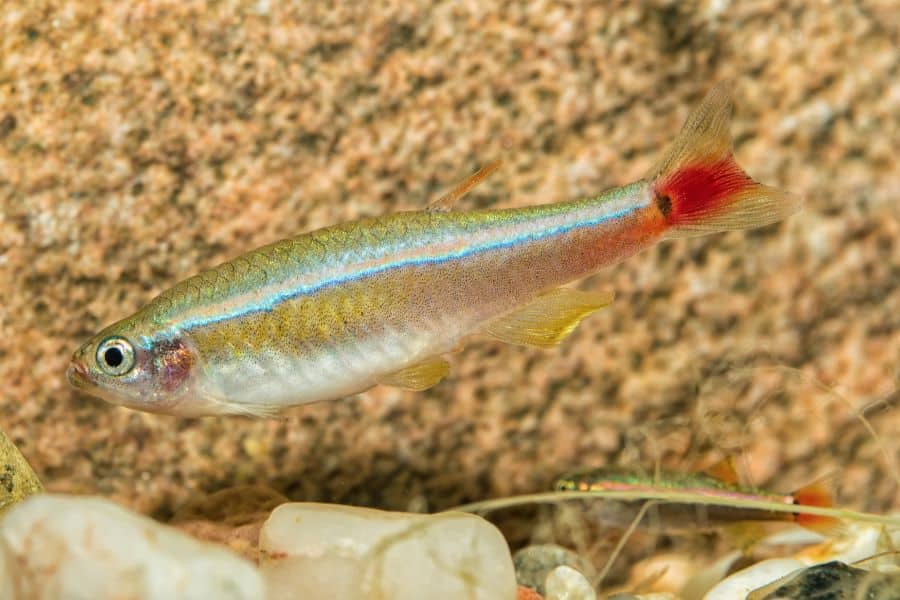White cloud mountain minnows, known as white cloud minnows, are a tiny but resilient freshwater fish species native to China’s Guangdong Province that have long been intrigued by aquarium lovers.
Due to their simplicity of maintenance, versatility, and attractive look, these fish are sometimes regarded as the best species for beginners.
White cloud minnows bring a pop of color and vibrancy to any aquarium with their glistening scales and colorful fins.
In this article, we will delve into the natural habitat and characteristics of White cloud minnows, as well as provide essential information on how to properly care for these fish in captivity.
Additionally, we will offer tips for breeding White cloud minnows for those looking to take their aquarium hobby to the next level. Read on to learn everything you need to know about the White cloud minnow, whether you are an experienced aquarium enthusiast or just getting started.
White Cloud Mountain Minnows Overview
| Scientific Name | Tanichthys albonubes |
| Size | 1.5 inches (3.8 cm) |
| Life Expectancy | 5 or more years |
| Temperament | Peaceful |
| Diet | Omnivorous |
| Tank Size | 2 gallons of water per fish; at least 10 gallons for 5 fish |
| Tank Temperature | 64-72°F (18-22°C) |
| Water Hardness | 5-19 dGH |
| Water pH | 6.0-8.0 |
Tanichthys albonubes, the White cloud minnow, is a tiny freshwater fish native to China’s Guangdong Province’s mountain streams and ponds.
Tan Kam Fei, a Chinese aquarist made the first official discovery of the species and was inspired by the fish’s beauty as he watched them swim about Hainan Island in the 1930s.
Shortly after, the White cloud minnow was introduced to the aquarium hobby, and because of its durability and simplicity of maintenance, it immediately became well-liked by hobbyists. In fact, the species thrived in captivity to the point that overfishing for the aquarium trade caused it to go extinct in the wild.
The White cloud minnow is currently regarded as an endangered species in its native environment. In the wild, White cloud minnows inhabit cool, fast-moving streams and mountain ponds with rocky substrates and plenty of vegetation.
They can endure a diverse spectrum of environmental conditions and could be spotted at elevations ranging from 800 to 1,200 meters. These freshwater creatures were also exported to other countries like Japan, the United States, and Korea where they can be seen in some streams.
Appearance
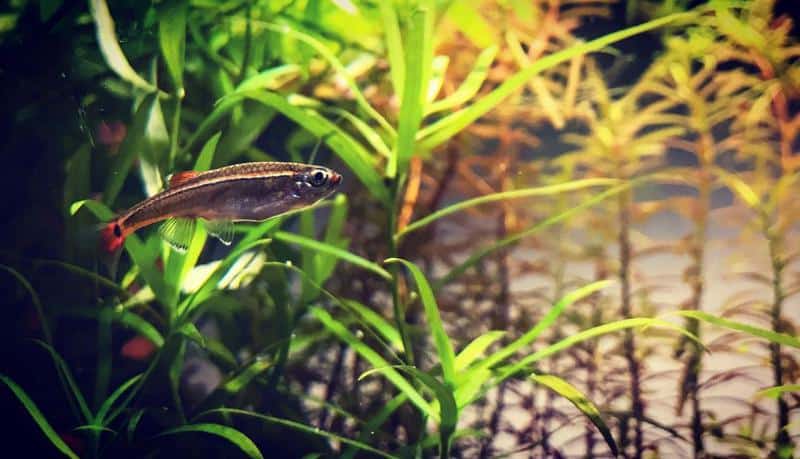
The White Cloud Minnow is a fragile, thin species capable of growing as big as 1.5 inches (3.8 cm). These little fish are a fun sight to observe as they gracefully move through the water.
They have an elongated body, pointed snout, and huge, round eyes. They are a popular option for nano tanks and for schooling fish in bigger aquariums due to their tiny size.
Anal fins are brought adjacent to the tail than dorsal fins, which are found near the back of the body. The White cloud minnow’s coloring is among its most distinctive characteristics.
The species gets its name from the iridescent silver scales that surround the pearly-white stripe that runs horizontally over its body. Their fins are typically a bright, fiery red-orange, although captive-bred specimens can exhibit a range of colors including gold, blue, green, and black.
Over the years, a number of selectively-bred color variants of the White cloud minnow have been developed by breeders.
The Meteor minnow has a metallic blue-black body and red-orange fins, the Golden minnow has a gold-colored body and red-orange fins, and the Vietnamese minnow has a black body with iridescent blue-green scales and fins are some of the most popular color variants.
Despite their diverse colorations, all White cloud minnows share the same basic body shape and resilient, peaceful temperament.
Temperament and Behavior
White cloud minnows are a great addition to a communal aquarium since they have a reputation for being calm. These are social fish that perform best in schools of six or more, and they get along well with other little, peaceful species like tetras, Danios, and Corydoras.
White cloud minnows are schooling fish in the wild; therefore, it is best to keep them together in captivity to minimize stress and encourage natural behavior. When kept in a well-planted aquarium with plenty of hiding places, White cloud minnows will often swim together in a tight school, darting back and forth in the water column.
One of the interesting behaviors of White cloud minnows is their affinity for jumping. The aquarium should always have a tight-fitting top on it since these fish are known to leap out of the water in quest of food.
They are also very active swimmers, so a larger aquarium with plenty of open swimming space is recommended. With proper care and attention, these little fish can live for several years and provide their owners with hours of entertainment as they display their natural behaviors.
Tank Requirements and Habitat
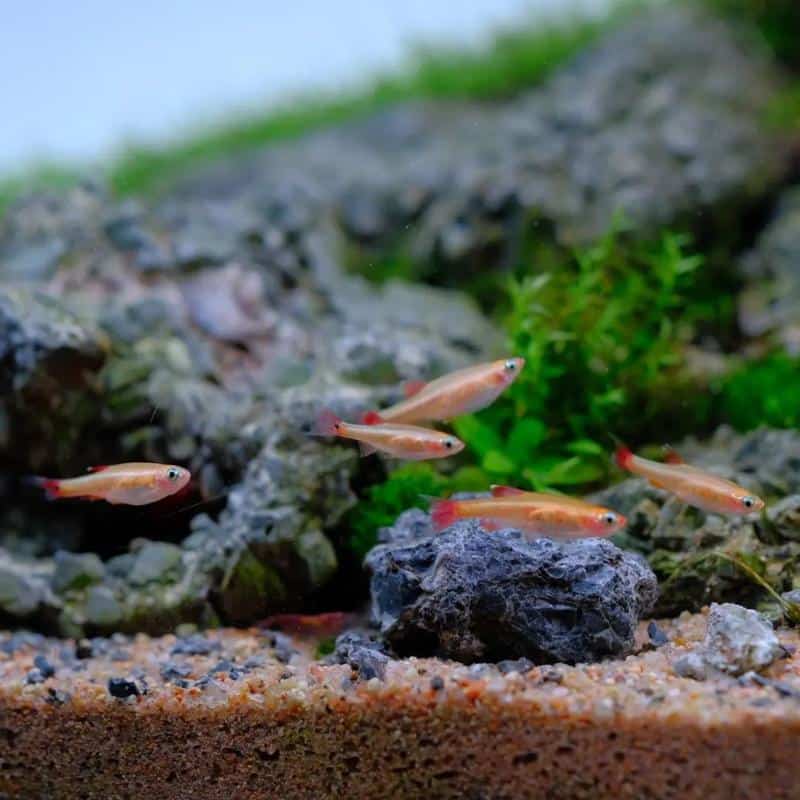
White cloud minnows are sturdy, tolerant fish that may survive in a variety of aquarium setups. While setting up a tank for these fish, it is important to take into consideration a few tank and habitat specifications.
Tank Size
White cloud minnows are little species that can only reach a size limit of 1.5 inches (3.8 cm). Yet, since they are aggressive swimmers, they need a lot of open swimming space. For a small group of White cloud minnows, a minimum tank size of 10 gallons is advised.
Tank Temperature
White cloud minnows are cold-water fish (can tolerate water temperature as low as 5 degrees celsius) that prefer a tank temperature between 64 and 72 degrees Fahrenheit (18 and 22 degrees Celsius). Although they can take somewhat higher temperatures, it is crucial to prevent abrupt temperature changes.
Lighting
White cloud minnows do not have any particular lighting needs, but it is crucial to maintain a natural day/night cycle in order to encourage healthy behavior and growth.
Water Requirements
White cloud minnows are adaptable fish that can tolerate a range of water conditions. They prefer slightly acidic to neutral water with a pH range of 6.0-8.0 and a water hardness of 5-19 dGH.
Plants
White cloud minnows are natural plant eaters, but they also benefit from having plenty of plants in their aquarium to provide hiding places and create a natural environment. Java moss, hornwort, and anubias are all good choices for a White cloud minnow tank.
Substrate
White cloud minnows prefer a fine-grain substrate that will not damage their delicate barbels. Sand or fine gravel are both good options.
Filtration
White cloud minnows create a considerable quantity of waste; thus, a robust filtering system is essential to preserving the water’s purity. A hang-on-back filter or sponge filter is recommended.
In general, setting up a tank for White cloud minnows is not too difficult. The key to encouraging their natural behavior and insuring their health and well-being is to provide a natural habitat with lots of swimming areas, plants, and hiding spots.
With proper care, White cloud minnows can live for several years and make a beautiful and entertaining addition to any aquarium.
Diet and Nutrition
White cloud minnows are omnivores that require a varied diet to maintain good health and vibrant coloration. They consume microscopic invertebrates, algae, and other plant materials in the wild.
White cloud minnows may be kept in captivity and are willing to eat a variety of commercially produced fish meals, such as flakes, pellets, and frozen feeds. It is crucial to pick foods of superior quality that have a balance of protein, carbohydrates, and other necessary nutrients.
In addition to prepared foods, White cloud minnows should also be offered live or frozen foods on occasion to provide additional nutrients and stimulate natural feeding behaviors. Brine shrimp, bloodworms, and daphnia are all good choices.
It is important to avoid overfeeding White cloud minnows, as they have small stomachs and can easily become overweight. A good feeding schedule is to offer small amounts of food two to three times per day and remove any uneaten food after a few minutes.
In addition to a varied diet, White cloud minnows also benefit from the presence of live plants in their aquarium. Plants not only provide hiding places and natural decoration, but they also help to provide supplemental nutrition and stimulate natural behaviors.
Overall, a varied diet and regular feeding schedule are key to keeping White cloud minnows healthy and vibrant. With proper nutrition and care, these small, peaceful fish can thrive in captivity and provide their owners with years of enjoyment.
How Can You Distinguish a Male from A Female?
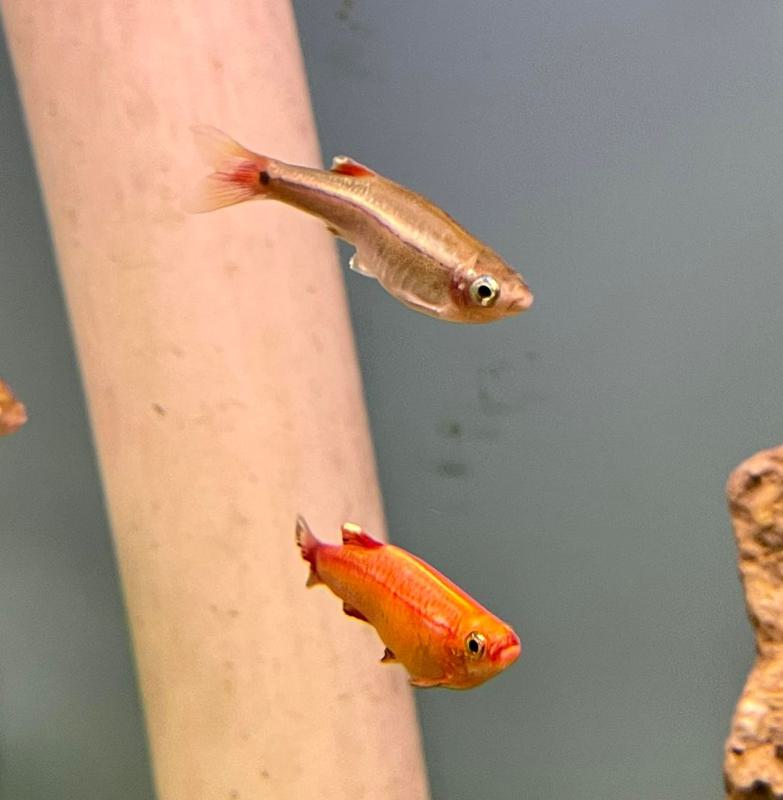
While male and female white cloud minnows are similar in size and form, distinguishing between them can be difficult. There are, however, a few small characteristics that can assist differentiate between males and females.
Seeing the color differences between male and female white cloud minnows is one of the simplest methods to differentiate between them. The color on the fins of male White cloud minnows is often brighter and deeper red than that of the females.
Females, on the other hand, tend to be paler in color and have more subdued fin coloration. Another way to distinguish between male and female White cloud minnows is by looking at their body shape.
In general, male white cloud minnows have a more prominent anterior fin and are frequently slimmer and sleeker than females. The anal fin and overall shape of females frequently appear more rounded.
Finally, during the breeding season, it may be possible to distinguish between male and female White cloud minnows by looking for the presence of breeding tubercles on the male’s head and pectoral fins. Breeding tubercles are small white bumps that develop on the male’s body as he prepares to spawn with a female.
Overall, while it can be challenging to distinguish between male and female White cloud minnows, careful observation of their coloration, body shape, and behavior can provide clues as to their gender.
Breeding
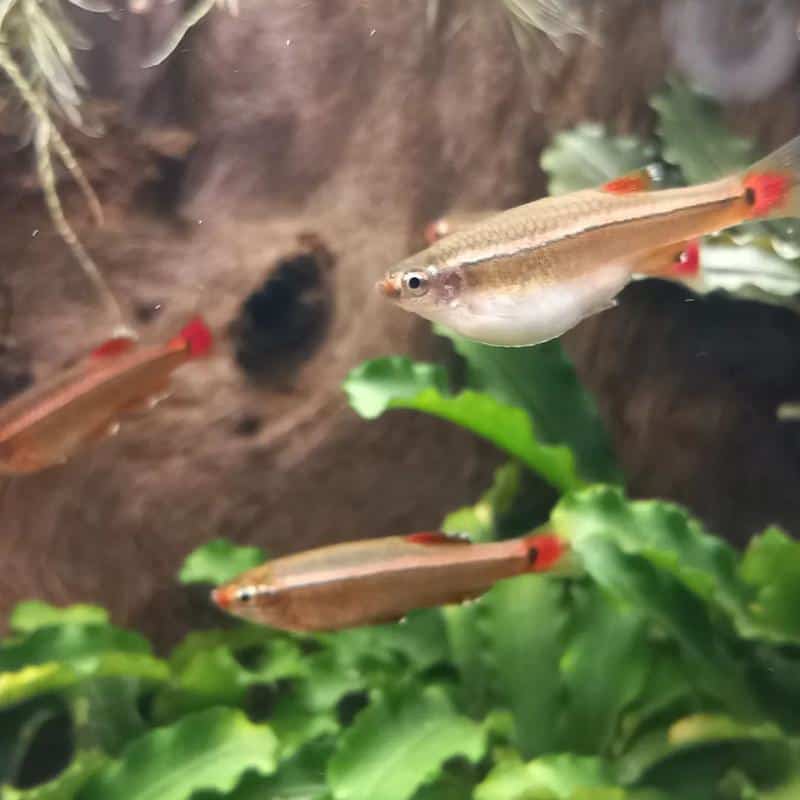
Breeding White cloud minnows is relatively easy and can be accomplished in a community aquarium with little effort. These fish are egg scatterers and will spawn readily in a well-maintained aquarium with proper water parameters.
To encourage breeding, it is important to provide your White cloud minnows with a suitable breeding environment. This can include providing plenty of live plants, a spawning mop or a breeding cone, and a separate breeding tank or partitioned section of your main tank.
Once you have created a suitable breeding environment, it is important to condition your White cloud minnows by feeding them a varied and nutritious diet, including live and frozen foods. It will make sure they are in good health and prepared to spawn.
Male White cloud minnows will pursue females all around the tank while courting the ladies and flaunting their fins when breeding circumstances are ideal. The male will fertilize the eggs after the female has laid them on the substrate, plants, or other surfaces.
Following spawning, it is crucial to separate the adults from the breeding aquarium to stop them from eating the eggs or fry. The eggs will hatch in 48–72 hours, and the fry will start swimming independently after a few days.
They can now be fed a diet consisting of infusoria or other tiny live feeds until they reach a maturity level where they can eat commercial fish food.
Overall, breeding White cloud minnows is a rewarding and relatively easy process that can be accomplished in a well-maintained aquarium with proper breeding conditions and careful attention to the needs of the fish.
Health Diseases
White cloud minnows are subject to a variety of illnesses and conditions just like any other fish. However, these problems may frequently be avoided or easily cured with adequate care and maintenance.
Dropsy
This condition, which affects the fish’s kidneys and results in fluid accumulation within the body, is brought on by a bacterial infection. Bloating, tiredness and increased scales are symptoms. Dropsy must be treated with antibiotics, and the diseased fish must be removed from the tank.
Fungal Infections
Stress, injuries, and poor water quality can all result in fungus infections. Lethargy, white spots on the body or fins, and frayed fins are other symptoms.
Maintaining proper water quality and avoiding tank overcrowding are essential for the prevention and treatment of fungal diseases.
Swim Bladder Disorders
These conditions can make it difficult for fish to swim and stay balanced in the water. Overfeeding, constipation or injuries are some of its causes. Give your fish a balanced diet and abstain from overfeeding to prevent swim bladder problems.
Velvet
Fish skin and gills are affected by the parasite condition known as velvet. Lethargy, difficulty breathing, and a golden or rusty coating on the skin are symptoms. The infected fish must be quarantined and given a treatment that kills the parasites in order to treat velvet.
To stop the illness from spreading to other fish in the tank, it is critical to act quickly if you observe any of these signs in your White Cloud Minnows.
FAQs
Can White Cloud Minnows Coexist Peacefully with Fish?
Absolutely, White Cloud Minnows may be kept together with other calm fish species since they are often peaceful. They should not be kept with bigger, more aggressive fish, since they could mistake them for food.
Do White Cloud Minnows Need a Heater?
White Cloud Minnows could survive in waters that are a little cold; however, in certain locations, a heater might be necessary to maintain the water at a constant temperature.
It is important to select a heater adequate for the size of your tank and to periodically monitor the temperature.
Can White Cloud Minnows Jump out Of the Tank?
Indeed, White Cloud Minnows may escape from a tank when attacked or under distress, just like many other fish species. Having a tight-fitting aquarium top is vital for avoiding this.
Can White Cloud Minnows Tolerate Saltwater?
No, White Cloud Minnows cannot survive in saltwater conditions since they are freshwater fish. They need water that is clear, pure and has the right pH, hardness, and other water parameters.
Conclusion
Freshwater fish hobbyists commonly choose the intriguing and attractive White Cloud Minnow as their aquarium pet. They are calm and simple to care for and if given the right care, may survive for a number of years.
They could make an excellent addition for both novice and seasoned fish keepers due to their hardiness and adaptability to a variety of water conditions.
By providing an appropriate tank size, temperature, and water quality, along with a balanced diet and regular maintenance, you can enjoy the lively and captivating presence of White Cloud Minnows in your aquarium.
